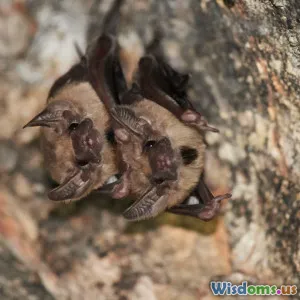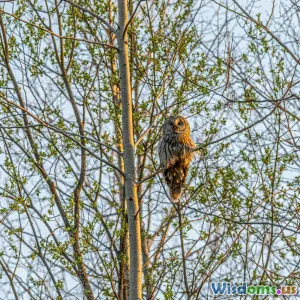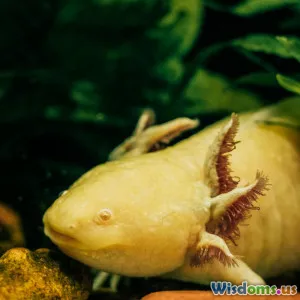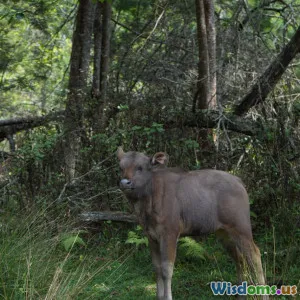
How You Can Contribute to Endangered Bat Conservation
15 min read Learn practical ways individuals can aid endangered bat conservation and help preserve vital ecosystems through awareness, volunteering, and habitat protection. (0 Reviews)
How You Can Contribute to Endangered Bat Conservation
Bats, though often shrouded in myth and misconception, play a pivotal role in the health of our ecosystems and agricultural landscapes. From pollinating tropical fruits to controlling agricultural pests, their nocturnal work supports global biodiversity and the very food systems we rely upon. Yet, bats are among the world's most threatened mammals, with over 200 species listed as endangered or vulnerable. Whether you're a concerned citizen, dedicated conservationist, or simply a lover of wildlife, there are tangible ways you can join the global effort to safeguard these fascinating creatures.
Understanding Why Bats Matter

Before exploring actions for bat conservation, it's critical to grasp why their survival is so important.
-
Natural Pest Control: Bats consume vast quantities of insects each night. For example, a single little brown bat can eat 1,000 mosquito-sized insects per hour, significantly reducing the need for chemical pesticides in agriculture.
-
Pollination and Seed Dispersal: In tropical regions, fruit bats are primary pollinators of plants like bananas, mangoes, agave (the source of tequila), and durian. These bats help maintain healthy ecosystems and robust crop yields.
-
Bats as Bioindicators: Because of their sensitivity to habitat changes, bats are key indicators of environmental health, alerting scientists and conservationists to changes in ecosystem stability.
Yet, habitat destruction, disease (such as White-Nose Syndrome), pesticide use, and persecution by humans have led to steep declines in many bat populations worldwide.
Getting Involved in Local Habitat Protection

One of the most effective ways to protect bats is to safeguard their natural habitats at the local level. Individuals and communities can:
-
Support Land Preserves and Reserves: Advocate for protected woodlands, wetlands, and caves in your area or region. For example, in the U.S., organizations such as Bat Conservation International work to protect critical roosts through legal defense and acquisition.
-
Conserve or Restore Natural Roosts: Dead trees, mature forests, and caves are vital bat roosting sites. Participate in habitat restoration days or tree-planting drives. Volunteer with local environmental groups or land trusts to monitor or maintain known bat colonies.
-
Install Bat Houses: Providing safe, artificial roosts helps compensate for the decline of natural nesting sites. Building and installing a bat house—a box with crevices for bats to roost—is a rewarding hands-on project. Local organizations or online guides (like Bat Conservation International's Bat House Builder’s Handbook) offer step-by-step directions for success.
-
Advocate Against Pesticide Use: Pesticides reduce food resources for bats and contaminate their environment. Support organic farms or local businesses that eschew chemical use and encourage your community to adopt pesticide-free practices.
Supporting Research & Monitoring Efforts

Scientific research is essential for understanding bat populations and crafting effective conservation strategies. You can contribute to research even without a science degree:
-
Participate in Citizen Science Programs: Many conservation organizations engage the public in bat monitoring. For example, Bat Conservation Trust in the UK operates annual National Bat Monitoring Programs, training volunteers to record bat calls using hand-held bat detectors.
-
Learn About Acoustic Bat Monitoring: Modern bat detectors translate ultrasonic echolocation calls into sounds humans can hear, or into visual sonograms. Some apps even use your smartphone to log bat calls, allowing valuable data collection in your own backyard.
-
Assist in Data Collection and Mapping: Many conservation groups seek help setting up mist nets or acoustic traps during fieldwork. Contact your local wildlife agency or university to see if you can join such projects. Remember, bat handling and close contact should only be done with training and protective equipment to avoid stress on animals and reduce disease risk.
-
Organize or Join Glossary Walks and Talks: Help educate your community by partnering with scientists or conservationists to host "bat walks," using detectors to listen for bats at dusk and demystifying bats for attendees. This builds local appreciation as well as valuable data.
Creating and Protecting Bat-Friendly Gardens

Your own outdoor space can be transformed into a sanctuary for bats with thoughtful planning:
-
Plant a Night Blooming Garden: Include flowers such as evening primrose, nicotiana, and moonflower, which open or emit scent at night and attract moths and other nocturnal insects bats love to hunt.
-
Avoid Bright Lights: Excessive artificial lighting can deter bats from foraging and disrupt their natural navigation. Where possible, use motion-sensor lights, shield outdoor bulbs, or switch to red-spectrum lighting which is less disturbing for nocturnal animals.
-
Provide Fresh Water: A clean pond or birdbath attracts a variety of insects, providing food for bats. Ponds especially draw species like the common pipistrelle in Europe, which skim low over the water to drink and hunt.
-
Leave Some Wild Space: Long grass, dense shrubs, and brush piles offer shelter for insects that bats eat. A less manicured garden is often a boon for wildlife diversity—including bats.
Combatting Misinformation and Promoting Bat Education

One of the greatest obstacles to bat conservation is persistent misunderstanding and baseless fears. By arming yourself with knowledge, you can:
-
Challenge Harmful Myths: Many people still believe bats are blind, prone to fly into hair, or are simply "disease-ridden pests." In reality, bats have excellent night vision (many even see better at night than humans), use sophisticated echolocation, and most species actively avoid humans.
-
Share Positive Experiences: Speak about your encounters with bats positively and encourage others to view them as important members of local ecosystems. Share photos or attend storytelling events, especially at libraries or school classrooms.
-
Engage with Local Schools: Arrange bat talks with local wildlife organizations for students. Distribute educational resources and foster a new generation of bat supporters.
-
Support Bat Education Initiatives: Donate books or materials to schools and libraries, or sponsor outreach programs by conservation organizations.
Reducing Personal Risks to Bats

Some everyday choices can make an outsized difference for neighborhood bats:
-
Exclude Bats Humanely from Buildings: If bats roost inside your home, never attempt to trap or poison them. Contact local wildlife specialists, who can safely and legally exclude bats outside of maternity season, ensuring no pups are left behind.
-
Secure Pets at Night: Domesticated cats or dogs sometimes hunt or disturb bats. Keeping pets indoors at night, especially during summer pupping season, reduces preventable mortality.
-
Seal and Repair Dangerous Entrances: Loose screens, attic vents, or open chimneys can unintentionally trap or expose bats. Conduct seasonal checks of your home to make it bat-safe, both for your sake and theirs.
Advocating for Policy and Supporting Conservation Funding

Structural change often requires public advocacy and sustainable financing. You can:
-
Support Protective Legislation: Call on politicians to maintain or strengthen wildlife protection acts. In the U.S., the Endangered Species Act covers several bat species; internationally, treaties like the Agreement on the Conservation of Populations of European Bats (EUROBATS) provide frameworks for cooperative conservation.
-
Stay Informed on Land Use Changes: Pipeline expansions, wind farms, and new developments can all impact bat habitats. Voice your concerns in public consultations, emphasizing the necessity to protect critical roost sites and migration corridors.
-
Donate or Fundraise for Conservation Organizations: Direct financial support helps maintain research, rescue, and public education initiatives. Notable organizations include Bat Conservation International, the Lubee Bat Conservancy, and your local bat trust or wildlife rescue.
-
Encourage Corporate Responsibility: Urge businesses to adopt bat-friendly practices, like off-setting development impacts with habitat restoration or hosting educational events for employees.
Supporting Restoration After Disease Outbreaks

Diseases like White-Nose Syndrome (WNS) in North America have devastated entire bat populations, especially hibernating species like the little brown bat and tricolored bat. The following actions are vital:
-
Practice Responsible Caving: Cavers and hikers can accidentally carry WNS spores between caves on clothing or gear. Always follow decontamination guidelines provided by agencies like the U.S. Fish and Wildlife Service.
-
Participate in Disease Monitoring: Trained volunteers help detect sick or deceased bats, collect valuable epidemiological data, and inform researchers of new outbreaks. If you live in or near hibernation sites, ask bat conservation groups how you can assist.
-
Advocate for Increased Funding: Disease response research is grossly underfunded compared to other conservation crises. Contact public officials or participate in fundraising drives aimed specifically at understanding and combating bat diseases.
Harnessing the Power of Community

Tackling bat conservation alone is daunting, but in unity, even small efforts compound dramatically:
-
Join or Form a Bat Conservation Group: Whether a neighborhood club or an official nonprofit, collaborative groups have greater organizing power for projects like bat house installation, night walks, habitat surveys, and outreach.
-
Participate in Annual Bat Events: International Bat Night (held across Europe every August), National Bat Week (October in the U.S.), and other wildlife celebrations engage and educate thousands. Get involved as a volunteer—or an enthusiastic attendee!
-
Share Success Stories: Amplify initiatives that worked in your area or city. For instance, the city of Austin, Texas is famous for the Congress Avenue Bridge colony of 1.5 million free-tailed bats; instead of removing them, the city transformed them into a major ecotourism attraction, benefiting local business and conservation.
-
Engage Digitally and Build Networks: Use social media to follow and share conservation news, join online forums of bat enthusiasts, and connect researchers with eager citizen scientists.
Bat conservation is not simply the domain of biologists or policymakers—it’s a collective mission uniting nature lovers, farmers, urban dwellers, educators, and students. Whether by loading a bat house, gardening for night pollinators, advocating for legal protection, or sharing what you know, your actions support some of Earth’s most vital and misunderstood mammals. By working together at every level—home, neighborhood, and nation—we can ensure a future where bats continue their irreplaceable ecological roles, enchanting us from the night skies for generations to come.
Rate the Post
User Reviews
Popular Posts



















